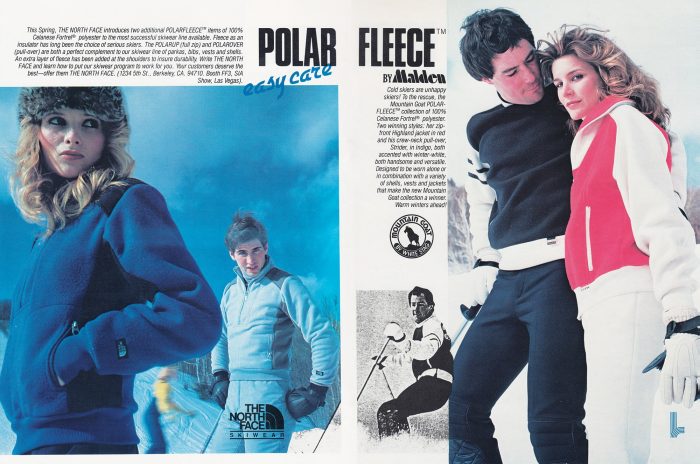Polartec® and the evolution of fleece as a go-to mid-layer

Most of you probably own a fleece item that you bring out every winter season as a versatile, warming layer – be it garment, hat or gloves. We all know it to be that soft, comfortable fabric that just makes you feel lovely and snug when outdoors in winter! Made from synthetic fibres, fleece is breathable – letting moisture escape whilst preventing the cold from getting in and disrupting your body temperature. But, what is the story behind this go-to fabric of outdoor gear?
The origins of fleece
40 years ago, outdoor company Patagonia® collaborated with a textile manufacturer known as Malden Mills. They came up with a soft, double-faced polyester fabric that had reduced pilling and was softer than what was currently in the market – fleece was born!
Patagonia named it ‘Synchilla’ and brought its first garments to market in 1981. Malden Mills called it ‘Polarfleece’. By the end of the 1980s, fleece had become the cornerstone for insulating materials, with the brand Polartec established by Malden Mills in 1991. Even today, fleece remains a premier insulating fabric that’s versatile. Polartec fleece was even named by Time magazine as part of its Top 100 of the ‘20th Century’s Greatest Inventions’.

In 2021, Polartec is not only celebrating 40 years since the invention of fleece, but also the stream of innovations that has inspired. Polartec’s campaign – “Peaking since 91” – launched on the 1st February 2021, celebrates 30 years of invention by the brand.
30 years of Polartec
Polartec is an industry leader in post-consumer recycling. In 1993, two years after the brand was established, the first fleece made from recycled plastic bottles was launched. To date, Polartec has recycled over 1.8 billion plastic bottles, saving them from landfill and turning them into premium fabrics.

In recent years, we have all become more environmentally conscious and focus has turned to the impact of materials that release microfibres. Microfibre Shedding is where materials, such as polyester, release tiny particles into water when washed, leading to microplastic pollution in the environment (primarily the ocean). Something we would all like to see reduced, and ideally, prevented in the future.
Polartec’s latest innovation – Power Air – focuses on providing more sustainable options for the market. It harnesses the qualities of fleece but reduces microfibre shedding during washing – by over five times that of a traditional mid-layer fabric.
Key achievements during 30 years of Polartec:
- 1981 Fleece: first synthetic fleece. Ever.
- 1993 Recycled Fleece: the first fleece fabric made from recycled plastic. Ever.
- 1998 Power Grid – the first bi-component knit structure
- 1998 Power Shield – the first real soft shell that would become the one truly air permeable NeoShell
- 2001 High Loft – the first fleece modification – an extra lofted fibre fabric
- 2012 Alpha – the first Active Insulation fabric
- 2015 Delta – the first Evaporative Cooling fabric
- 2018 Power Air – the first Anti-Shedding fabric
Why is fleece important as a mid-layer?
It is all about insulation! It is not ideal being outdoors if your gear does not help keep you warm and comfortable so you can just enjoy yourself. Your mid-layer garment will manage the moisture/sweat your base layer has drawn outwards – if moisture soaks in, then your garment will be ineffective and you will get horribly clammy and cold. This is why caring for your mid-layer properly is just as important as caring for your base layer or waterproof, so that you can regulate your body temperature.
There are other fabrics used for mid-layers, these include Merino wool – which you can wash less frequently than a synthetic garment and has odour-reducing properties. Down – which is lightweight and easy to pack down, but does not always cope well if it gets wet. Synthetic – which will wick moisture out and dry quickly, but could lead to bacterial odour build-up, resulting in you washing items more often.
Fleece mid-layers come in different thicknesses, so you can definitely find the one most compatible for your outdoor needs. If you’re a fleece fan like us, you’ll have multiple fleeces of differing thicknesses – who says less is more! It is a versatile fabric to keep you comfortable in a range of weather conditions.

Don’t forget to care for your fleece with Nikwax
Fleece, in general, is a durable fabric that will keep you warm year after year if you look after it correctly. There is one very easy way to keep your fleece gear in prime condition…
Nikwax offers specialist aftercare for fleece that can also make it water repellent, if you’ve ever had a pair of fleece gloves and they’ve got wet, you will know how ineffective wet fleece is!
Rather than using standard washing detergents and fabric conditioners, which will attract water and allow the fleece to become soggy, use Nikwax water-based aftercare so you stay drier and warmer for longer.
We recommend that you clean your fleece with Nikwax Tech Wash®, you can throw it in the wash with your waterproof jacket, or any other outdoor items that require cleaning. Then proof the item(s) with Nikwax PolarProof® – to help keep your fleece performing at its best.
Overall, PolarProof will help enhance the performance and increase the usable lifetime of your fleece gear by:
- Providing water repellency, thereby preventing fabric weight gain
- Enhancing breathability and reviving insulation
- Reducing the pilling of fleece fabric
- Optimising performance in wet weather.
PolarProof is PFC-free, made with care for the environment.


Leave a Reply